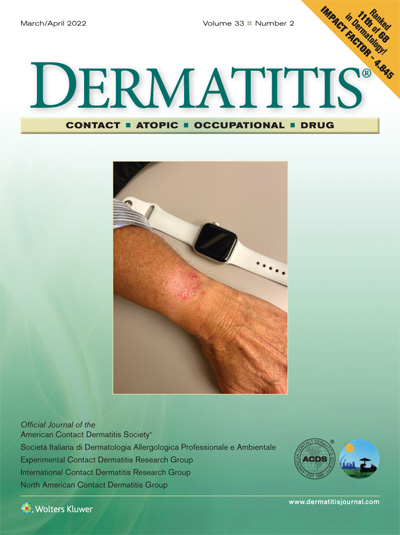二光酸氯己定1%水溶液的斑贴试验:北美接触性皮炎组经验,2015-2020。
IF 3.2
3区 医学
Q1 DERMATOLOGY
引用次数: 0
摘要
背景:氯己定是一种可能引起过敏性接触性皮炎的防腐剂。目的:了解氯己定变态反应的流行病学特点,并对阳性斑贴试验反应进行定性分析。方法:本回顾性研究分析2015-2020年北美接触性皮炎组进行1%二光酸氯己定贴片试验的患者。结果:14731例患者中,107例(0.7%)出现过敏反应;其中,56例(52.3%)反应是目前临床相关的。大多数(59%)反应为轻度(+),其次是强烈(++,18.7%)和非常强烈(+++,6.5%)。氯己定阳性患者常见的原发性皮炎解剖部位为手部(26.4%)、面部(24.5%)和散点/全身分布(17.9%)。与阴性患者相比,氯己定阳性患者发生累及躯干皮炎的可能性显著增加(11.3% vs 5.1%;p = 0.0036)。最常见的来源类别是皮肤/保健产品(n = 41, 38.3%)。只有11例(10.3%)氯己定反应与职业相关;其中,81.8%是卫生保健工作者。结论:二光酸氯己定过敏不常见,但常与临床相关。手、脸和分散的广义模式的参与是常见的。职业相关反应主要见于卫生保健工作者。本文章由计算机程序翻译,如有差异,请以英文原文为准。
Patch Testing to Chlorhexidine Digluconate, 1% Aqueous: North American Contact Dermatitis Group Experience, 2015-2020.
Background: Chlorhexidine is an antiseptic that may cause allergic contact dermatitis. Objectives: To describe the epidemiology of chlorhexidine allergy and characterize positive patch test reactions. Methods: This retrospective study analyzed patients patch tested to chlorhexidine digluconate 1% aqueous by the North American Contact Dermatitis Group, 2015-2020. Results: Of 14,731 patients tested to chlorhexidine digluconate, 107 (0.7%) had an allergic reaction; of these, 56 (52.3%) reactions were currently clinically relevant. Most (59%) reactions were mild (+), followed by strong (++, 18.7%) and very strong (+++, 6.5%). Common primary dermatitis anatomic sites in chlorhexidine-positive patients were hands (26.4%), face (24.5%), and scattered/generalized distribution (17.9%). Compared with negative patients, chlorhexidine-positive patients were significantly more likely to have dermatitis involving the trunk (11.3% vs 5.1%; P = 0.0036). The most commonly identified source category was skin/health care products (n = 41, 38.3%). Only 11 (10.3%) chlorhexidine reactions were occupationally related; of these, 81.8% were in health care workers. Conclusions: Chlorhexidine digluconate allergy is uncommon, but often clinically relevant. Involvement of the hands, face, and scattered generalized patterns was frequent. Occupationally related reactions were found predominantly in health care workers.
求助全文
通过发布文献求助,成功后即可免费获取论文全文。
去求助
来源期刊

Dermatitis
医学-皮肤病学
CiteScore
5.30
自引率
11.50%
发文量
251
审稿时长
>12 weeks
期刊介绍:
Dermatitis is owned by the American Contact Dermatitis Society and is the home journal of 4 other organizations, namely Societa Italiana di Dermatologica Allergologica Professionale e Ambientale, Experimental Contact Dermatitis Research Group, International Contact Dermatitis Research Group, and North American Contact Dermatitis Group.
Dermatitis focuses on contact, atopic, occupational, and drug dermatitis, and welcomes manuscript submissions in these fields, with emphasis on reviews, studies, reports, and letters. Annual sections include Contact Allergen of the Year and Contact Allergen Alternatives, for which papers are chosen or invited by the respective section editor. Other sections unique to the journal are Pearls & Zebras, Product Allergen Watch, and news, features, or meeting abstracts from participating organizations.
 求助内容:
求助内容: 应助结果提醒方式:
应助结果提醒方式:


